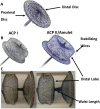Percutaneous Left Atrial Appendage Occlusion Therapy: Evolution and Growing Evidence
- PMID: 39077005
- PMCID: PMC11266471
- DOI: 10.31083/j.rcm2407211
Percutaneous Left Atrial Appendage Occlusion Therapy: Evolution and Growing Evidence
Abstract
Atrial fibrillation (AF) is the most common cardiac arrhythmia and if untreated, significantly increases both the risk of intracardiac thrombus formation and ischemic stroke. In patients with nonvalvular AF (NVAF), the left atrial appendage (LAA) has been estimated to be the source of thrombus development in 91% to 99% of cases. Consequently, oral anticoagulation (OAC) to provide stroke prevention has become the standard of care for most AF patients; however, OACs are associated with a risk of bleeding and their efficacy depends on optimal patient compliance. In terms of alternative approaches to preventing embolic events, surgical LAA excision was attempted as early as in the late 1940s in patients with valvular AF; LAA excision remains a recommendation in surgical guidelines for NVAF patients who need open-heart coronary bypass or valvular replacement/repair surgeries. However, due to its invasive nature surgical LAA intervention has limited clinical application in present cardiology practice. Percutaneous LAA occlusion (LAAO) is increasingly being performed as an alternative to OAC for stroke prevention; this is particularly the case in patients at increased bleeding risk. Substantial progress has been made in percutaneous LAAO therapy since its inception some twenty years ago. Herein we systematically review both the critical literature that led to the development of LAAO, and the increasing clinical evidence supporting the application of this treatment strategy in NVAF. To this end we focus on recently published critical evaluations of United States Food and Drug Administration (US FDA) and Conformité Européenne (Commercial Sale of Licensed Product in the EU) (CE-Mark) approved LAAO devices, summarize the current status of LAAO therapy, and discuss the future perspectives regarding the knowledge and technology gaps in this area by recognizing the potential contributions of many ongoing but likely transformative clinical trials.
Keywords: atrial fibrillation; left atrial appendage occlusion; oral anticoagulation; stroke prevention.
Copyright: © 2023 The Author(s). Published by IMR Press.
Conflict of interest statement
Dr. Han reports no conflict of interest. Dr. Benditt is a consultant for and/or has equity in Medtronic Inc, Abbott Labs and Advanced Circulatory Systems. Dr Benditt is supported in part by a grant from the Dr Earl E Bakken family.
Figures


Similar articles
-
Percutaneous devices for left atrial appendage occlusion: A contemporary review.World J Cardiol. 2019 Feb 26;11(2):57-70. doi: 10.4330/wjc.v11.i2.57. World J Cardiol. 2019. PMID: 30820276 Free PMC article. Review.
-
Minimally invasive left atrial appendage occlusion plus reduced dose direct oral anticoagulant to prevent stroke in patients with atrial fibrillation-the LAAO-PlusRE.Ann Cardiothorac Surg. 2024 Mar 29;13(2):146-154. doi: 10.21037/acs-2023-afm-18. Epub 2024 Mar 18. Ann Cardiothorac Surg. 2024. PMID: 38590988 Free PMC article. Review.
-
Left atrial appendage occlusion in recurrent ischaemic stroke, a multicentre experience.Acta Clin Belg. 2022 Apr;77(2):255-260. doi: 10.1080/17843286.2020.1821494. Epub 2020 Sep 20. Acta Clin Belg. 2022. PMID: 32951514
-
Percutaneous left atrial appendage occlusion: A review of current devices, clinical evidence, patient selection, and post procedural antithrombotic management.Prog Cardiovasc Dis. 2021 May-Jun;66:92-100. doi: 10.1016/j.pcad.2021.06.006. Prog Cardiovasc Dis. 2021. PMID: 34332665 Review.
-
Feasibility of Left Atrial Appendage Occlusion in Left Atrial Appendage Thrombus: A Systematic Review.JACC Clin Electrophysiol. 2020 Apr;6(4):414-424. doi: 10.1016/j.jacep.2019.11.017. Epub 2020 Jan 29. JACC Clin Electrophysiol. 2020. PMID: 32327075
Cited by
-
Left atrial appendage occlusion in atrial fibrillation: shaping the future of stroke prevention.Future Cardiol. 2025 May;21(6):391-404. doi: 10.1080/14796678.2025.2484964. Epub 2025 Mar 26. Future Cardiol. 2025. PMID: 40136040 Review.
-
Impact of atrial fibrillation centre on the implementation of the atrial fibrillation better care holistic pathway in a Chinese large teaching hospital: an interrupted time series analysis.BMJ Health Care Inform. 2025 Jul 23;32(1):e101315. doi: 10.1136/bmjhci-2024-101315. BMJ Health Care Inform. 2025. PMID: 40707050 Free PMC article.
-
'One Stop' Therapy has a Satisfying Performance on AF Patients with Interatrial Communication: Evidence from Pooled Clinical Experience.Rev Cardiovasc Med. 2025 Apr 16;26(4):26662. doi: 10.31083/RCM26662. eCollection 2025 Apr. Rev Cardiovasc Med. 2025. PMID: 40351666 Free PMC article.
References
-
- Wolf PA, Abbott RD, Kannel WB. Atrial fibrillation as an independent risk factor for stroke: the Framingham Study. Stroke . 1991;22:983–988. - PubMed
-
- Ferro JM. Cardioembolic stroke: an update. The Lancet. Neurology . 2003;2:177–188. - PubMed
-
- Virani SS, Alonso A, Aparicio HJ, Benjamin EJ, Bittencourt MS, Callaway CW, et al. Heart Disease and Stroke Statistics-2021 Update: A Report From the American Heart Association. Circulation . 2021;143:e254–e743. - PubMed
-
- Blackshear JL, Odell JA. Appendage obliteration to reduce stroke in cardiac surgical patients with atrial fibrillation. The Annals of Thoracic Surgery . 1996;61:755–759. - PubMed
-
- Cresti A, García-Fernández MA, Sievert H, Mazzone P, Baratta P, Solari M, et al. Prevalence of extra-appendage thrombosis in non-valvular atrial fibrillation and atrial flutter in patients undergoing cardioversion: a large transoesophageal echo study. EuroIntervention . 2019;15:e225–e230. - PubMed
Publication types
LinkOut - more resources
Full Text Sources

